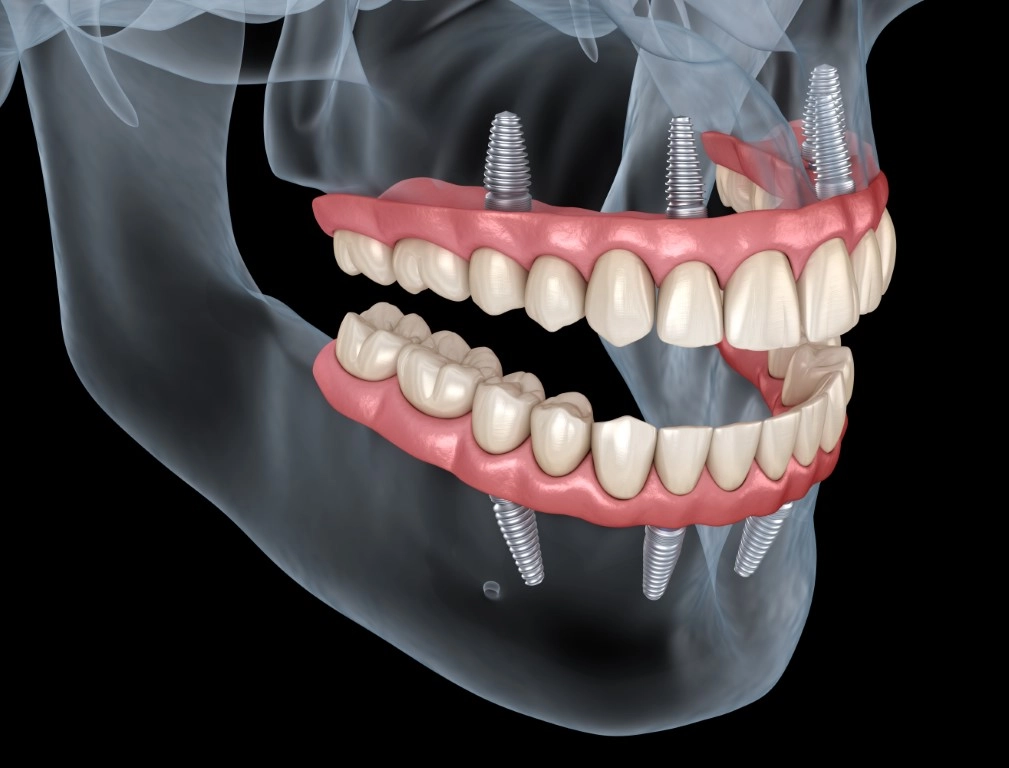Missing teeth are a serious issue, impacting dental health, chewing ability, and confidence. If you have missing teeth, you may be considering dental implants. However, bone loss can inhibit your ability to receive implants.
That’s where sinus augmentation comes in. Keep reading to learn more about what this procedure is, why it’s necessary, and how it can help you overcome bone loss and restore your smile.
What Is Sinus Augmentation?
Sinus augmentation, sometimes referred to as sinus lift surgery, is a surgical procedure that addresses bone loss in the upper jaw.
Your sinuses are air-filled pockets in the bones around your nose and face. In sinus augmentation surgery, the membrane of the maxillary sinuses (located on either side of the nose) are lifted to create additional space and add grafting material, allowing the jawbone to support dental implants.

Why Is Sinus Augmentation Necessary?
In order for dental implants to be stable and functional, you need sufficient jawbone. Without the proper support, implants can become loose, causing pain and infection. This is known as implant failure.
Those who want to replace missing upper teeth but have bone loss near the molars and premolars can undergo sinus augmentation to replace missing bone prior to receiving implants.
But why does bone loss occur in the first place? There are several possible causes:
- Missing teeth: Your jawbone needs stimulation from the tooth roots. If you’re missing a tooth, your jawbone doesn’t receive this stimulation, causing the bone to slowly deteriorate.
- Bacteria: Infections, abscesses, tooth decay, and gum disease can eat away at the jawbone, especially when left untreated.
- Osteoporosis: This condition causes bones to become brittle and lose density, which can affect the jawbone.
- Age: Bone density can decrease naturally with age, partially due to hormonal changes.
- Enlarged sinus cavities: Some people have larger sinuses than others, causing there to be less bone in the upper jaw.
Sinus augmentation ensures the long-term success of implants and greatly decreases the risk of failure.

What to Expect During the Procedure
Sinus augmentation is typically performed under local anesthesia, so you won’t feel any pain during the procedure. Once you’re totally numb, the dentist will create an incision in the gums, allowing them to access the sinus through a small window in the jawbone.
After that, the sinus membrane will be gently lifted, creating space for the bone graft material, which is placed between the jawbone and sinus cavity. The graft can come from your own body, a tissue donor, or even a cow bone — whichever you prefer.
Finally, the incision is stitched closed. From start to finish, the procedure typically takes 1–2 hours.
Recovery Process
For the first few days following the procedure, you may experience swelling, minor bleeding, and discomfort. Over-the-counter pain medications are typically effective for managing these symptoms. You may be instructed to use nasal spray to keep your nasal passages moist and promote healing.
To avoid dislodging the bone graft material, avoid blowing your nose or performing strenuous physical activities until you’re cleared by your dentist. Attend follow-up appointments to ensure you’re healing properly.
The bone graft will likely take several months to fully integrate. Once the dentist has confirmed that the bone has integrated successfully, you can proceed with dental implants.

Who Is a Good Candidate for Sinus Augmentation?
The ideal candidates for sinus augmentation are, of course, those with insufficient upper jawbone for implants. They must also be non-smokers with good overall health. Before surgery, Dr. B will perform X-rays or CT scans to evaluate your needs and determine the best approach.
If you have bone loss but are not a good candidate for sinus augmentation, you may be wondering what the alternative treatment options are. It may be possible to opt for shorter implants, but the risk of implant failure goes up as the implant length decreases. You could also opt for fewer implants placed farther forward in the mouth to support a bridge or dentures.
In some situations, implants may not be feasible at all. If this is the case, you may be able to use non-implant-supported bridges or dentures to replace your missing teeth.
Smile Solutions for Patients with Bone Loss
If you’ve been told you can’t receive dental implants due to bone loss, don’t lose hope. At Smile Solutions Dentistry, we’re proud to offer sinus augmentation to patients struggling with upper jawbone loss. This innovative procedure can allow you to experience the transformative benefits of dental implants, restoring your smile’s functionality and appearance. Contact us today to schedule your consultation!


Follow Us